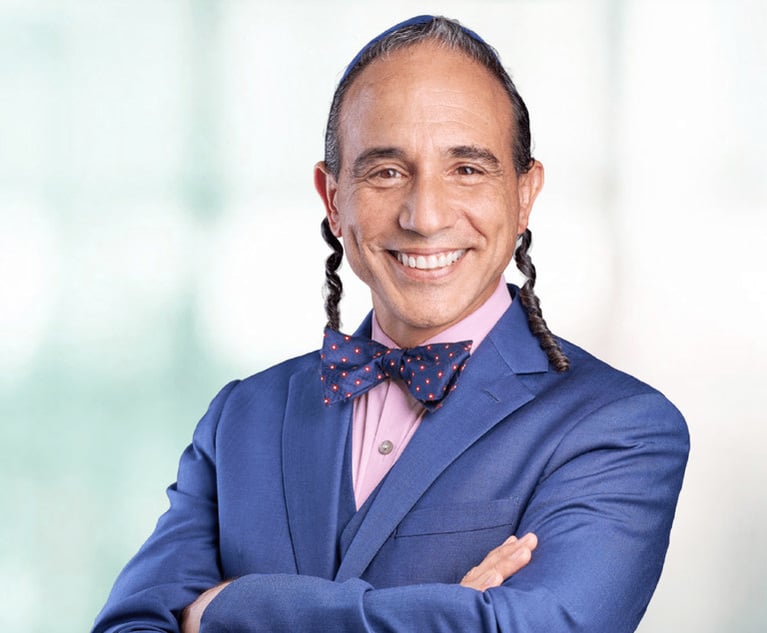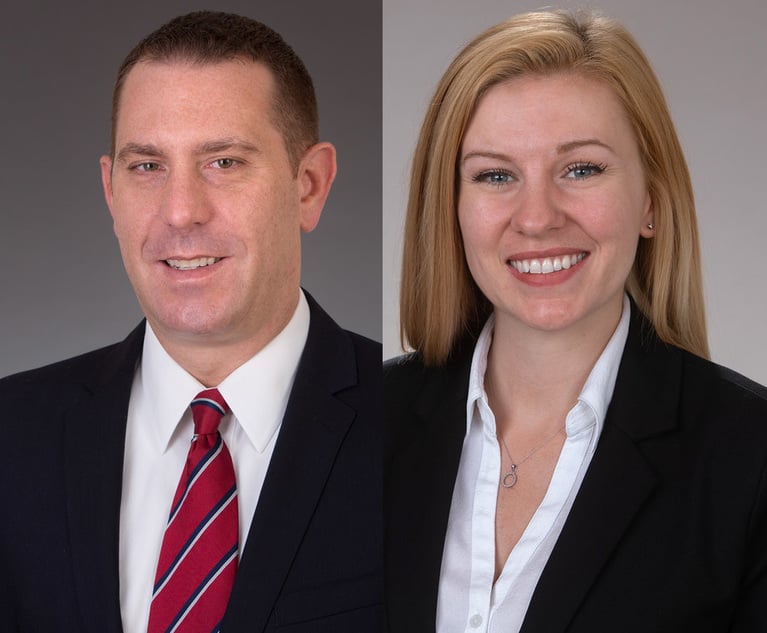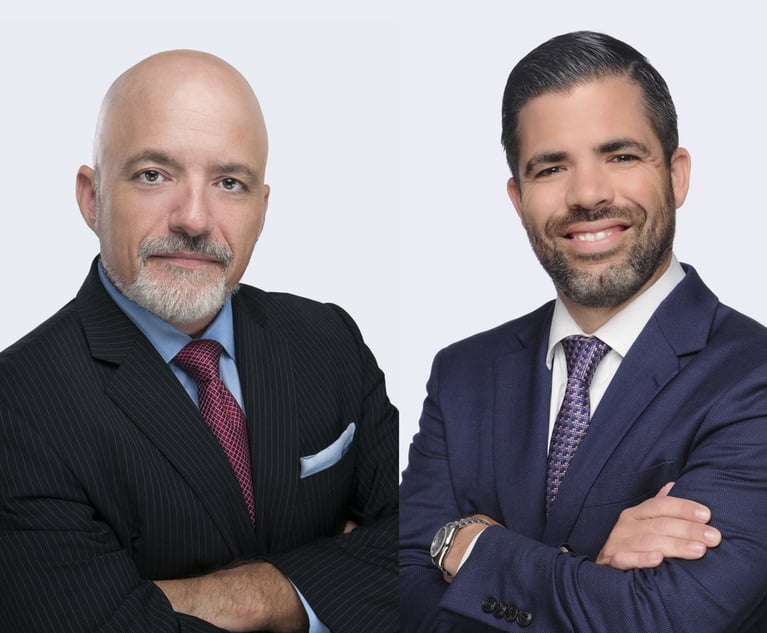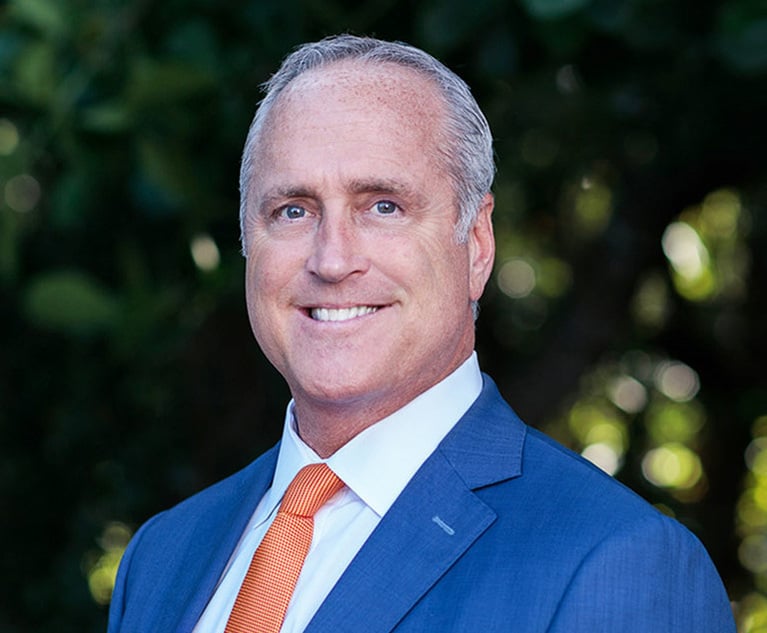Asset Fraud Starts With Humans and Can End With AI
Discovering the crimes and recovering stolen assets can be aided through forensic accounting along with artificial intelligence.
April 17, 2019 at 09:02 AM
7 minute read
 Sheri Fiske Schultz, left, and Katie Gilden, right.
Sheri Fiske Schultz, left, and Katie Gilden, right.
When it comes to occupational fraud, corporate corruption and financial statement fraud; they make headlines. But, the most common type of fraud—and most likely to affect your company—is asset misappropriation. Asset misappropriation, which includes cash and inventory theft schemes, occurs in more than 83 percent of all reported fraud cases. The most common type of asset misappropriation frauds are billing schemes and the costliest type is check tampering. The good news? Discovering the crimes and recovering stolen assets can be aided through forensic accounting along with artificial intelligence.
Asset misappropriation schemes result in the lowest losses of the three major categories of fraud tracked by the Association of Certified Fraud Examiners (ACFE), a median of $125,000 per scheme. Although significantly smaller than losses resulting from financial statement fraud (median loss of $975,000 per occurrence), a $125,000 loss would be hard for any business to withstand. And while the trade group's study shows that more than 25 percent of cases were found within the first six months, more than a third lasted at least two years before being discovered. The longer the fraud continues, the larger the loss.
Oftentimes, the fraudster is a long-term, trusted employee. Why do otherwise trustworthy workers with no criminal background perpetrate the fraud? ACFE research has identified three major causes: pressure (for example, individual financial problems), perceived opportunity and rationalization (the perpetrator is a good person dealing with bad circumstances). To cover their tracks, fraudsters usually alter physical documents or create fraudulent ones. Less than 6 percent do not conceal their theft.
A total of 29 percent of fraud examiners surveyed say perpetrators get away with the crime for a while due to a clear lack of internal controls. Another 20 percent say that internal controls were present but had been overridden by the perpetrator. While many people tend to think that only larger companies have the resources for implementing controls, implementation of internal controls is possible even in businesses with only a handful of employees.
As one might expect, the greater an individual's authority, the greater the losses. The ACFE found that while less than 20 percent of fraud was committed by executive-level employees, the median loss per incident was $703,000.
The older the person, the greater the loss is likely to be, the association found in surveys started in 1996. While less than 3 percent of fraud was committed by people over age 60, the median loss is $630,000, the largest amount of any age range. The median loss was $250,000 or higher among people over 40 versus a maximum median in any year of surveying of $100,000 for those under that age.
A person's past will provide few clues. ACFE surveys found that only 5.2 percent of perpetrators had prior convictions for a fraud-related offense. About 83 percent had never been terminated or punished for any form of fraud-related conduct.
The takeaway? Background checks aren't enough. Remember that Bernie Madoff didn't have a criminal background … until he got caught. In fact, the ACFE study found that 40 percent of cases were never referred to law enforcement. Oftentimes perpetrators receive no punishment from their employers, are permitted to resign or enter into settlement agreements that typically are confidential.
In more than 91 percent of cases, at least one behavioral red flag was identified prior to fraud detection. So, what red flags should business owners be aware of? Here are the most common behavioral red flags in perpetrators:
- Living beyond their means;
- Financial difficulties;
- Unusually close association with a vendor or customer;
- A general “wheeler-dealer” attitude involving shrewd or unscrupulous behavior;
- Excessive control issues or unwillingness to share duties;
- Recent divorce or family problems; and
- Employees not taking vacations.
Business owners can discover asset misappropriation several ways, including hiring an experienced forensic accountant. The human factor in the form of tips often prompts an investigation. Tips account for 39 percent of initial detections, while an internal audit edged up to second in the 2016 study, just ahead of a management review. Tips and internal audits have the biggest impact at companies with 100 or more employees.
For all companies, just over half of tips come from employees, about 18 percent from customers and 10 percent from vendors. Another 14 percent come from anonymous sources. Any form of anonymous reporting mechanism is a great way to obtain tips, whether it be through telephone hotlines, email or web-based forms.
These outside sources of help, known as passive detection, are particularly useful when the business owner encourages them. Active detection—a deliberate search for misconduct at the direction of someone within the organization or an internal control or process—tends to catch fraud sooner and result in smaller losses.
Whether through a tip or review, or even the accidental discovery, the investigation begins when forensic accountants like us arrive on the scene. We pore over bank statements, cancelled checks, deposit slips and wire transfers. We hunt for PayPal, eBay and Amazon accounts. We also conduct something called a horizontal analysis that looks for trends in profit margins, liquidity and other indicators. We then turn to vertical analysis and examine internal ratios such as revenue and expenses as a percentage of sales.
In this age of nearly unlimited computing power, we put to work artificial intelligence software. It creates a database from a mess of documents that can be searched quickly in a meaningful way. Using data analytics combined with artificial intelligence, we can easily break down transactions and discover abnormalities such as invoices on weekends when the company is closed or bills for amounts that don't make sense.
Artificial intelligence can look for round numbers faster than a human and relate the incidences to results from other queries. Similarly, it can apply Benford's Law, a statistical analysis that looks for irregular distribution of digits to discover patterns that warrant investigation.
However, this tool is not a modern Sherlock Holmes. It doesn't tell us what's wrong with the financials, just where to look. For example, it can identify patterns of payments or use Google Maps to show the location of a vendor and its geographical connection to employees.
Detection tools and sharp-eyed forensic accountants can put a stop to fraud, but the ACFE surveys have found that recovering losses isn't easy. Just under 60 percent of victims had yet to recover any money, and only 12 percent recovered all of their losses. While many victims in the most recent study might still be in the process of recovering losses, the data shows that such efforts can take time and might never result in a full recovery.
As with all property crime, prevention is the best policy. Companies should implement controls and process that increase the likelihood of active detection. These include educating employees, active management review and the proper implementation and adherence to internal controls. Forensic accountants and other security experts can help you set up and effectively use these deterrents, which can be the difference between profitability and financial ruin.
Sheri Fiske Schultz is managing director of Fiske & Company, one of South Florida's most highly recommended CPA firms. She offers both professional expertise and practical insight toward business valuations and litigation support services.
Katie Gilden, principal at the firm, joined in November 2009 in the forensic accounting and litigation services practice.
This content has been archived. It is available through our partners, LexisNexis® and Bloomberg Law.
To view this content, please continue to their sites.
Not a Lexis Subscriber?
Subscribe Now
Not a Bloomberg Law Subscriber?
Subscribe Now
NOT FOR REPRINT
© 2025 ALM Global, LLC, All Rights Reserved. Request academic re-use from www.copyright.com. All other uses, submit a request to [email protected]. For more information visit Asset & Logo Licensing.
You Might Like
View All



Trending Stories
- 1Ex-Kline & Specter Associate Drops Lawsuit Against the Firm
- 2Am Law 100 Lateral Partner Hiring Rose in 2024: Report
- 3The Importance of Federal Rule of Evidence 502 and Its Impact on Privilege
- 4What’s at Stake in Supreme Court Case Over Religious Charter School?
- 5People in the News—Jan. 30, 2025—Rubin Glickman, Goldberg Segalla
Who Got The Work
J. Brugh Lower of Gibbons has entered an appearance for industrial equipment supplier Devco Corporation in a pending trademark infringement lawsuit. The suit, accusing the defendant of selling knock-off Graco products, was filed Dec. 18 in New Jersey District Court by Rivkin Radler on behalf of Graco Inc. and Graco Minnesota. The case, assigned to U.S. District Judge Zahid N. Quraishi, is 3:24-cv-11294, Graco Inc. et al v. Devco Corporation.
Who Got The Work
Rebecca Maller-Stein and Kent A. Yalowitz of Arnold & Porter Kaye Scholer have entered their appearances for Hanaco Venture Capital and its executives, Lior Prosor and David Frankel, in a pending securities lawsuit. The action, filed on Dec. 24 in New York Southern District Court by Zell, Aron & Co. on behalf of Goldeneye Advisors, accuses the defendants of negligently and fraudulently managing the plaintiff's $1 million investment. The case, assigned to U.S. District Judge Vernon S. Broderick, is 1:24-cv-09918, Goldeneye Advisors, LLC v. Hanaco Venture Capital, Ltd. et al.
Who Got The Work
Attorneys from A&O Shearman has stepped in as defense counsel for Toronto-Dominion Bank and other defendants in a pending securities class action. The suit, filed Dec. 11 in New York Southern District Court by Bleichmar Fonti & Auld, accuses the defendants of concealing the bank's 'pervasive' deficiencies in regards to its compliance with the Bank Secrecy Act and the quality of its anti-money laundering controls. The case, assigned to U.S. District Judge Arun Subramanian, is 1:24-cv-09445, Gonzalez v. The Toronto-Dominion Bank et al.
Who Got The Work
Crown Castle International, a Pennsylvania company providing shared communications infrastructure, has turned to Luke D. Wolf of Gordon Rees Scully Mansukhani to fend off a pending breach-of-contract lawsuit. The court action, filed Nov. 25 in Michigan Eastern District Court by Hooper Hathaway PC on behalf of The Town Residences LLC, accuses Crown Castle of failing to transfer approximately $30,000 in utility payments from T-Mobile in breach of a roof-top lease and assignment agreement. The case, assigned to U.S. District Judge Susan K. Declercq, is 2:24-cv-13131, The Town Residences LLC v. T-Mobile US, Inc. et al.
Who Got The Work
Wilfred P. Coronato and Daniel M. Schwartz of McCarter & English have stepped in as defense counsel to Electrolux Home Products Inc. in a pending product liability lawsuit. The court action, filed Nov. 26 in New York Eastern District Court by Poulos Lopiccolo PC and Nagel Rice LLP on behalf of David Stern, alleges that the defendant's refrigerators’ drawers and shelving repeatedly break and fall apart within months after purchase. The case, assigned to U.S. District Judge Joan M. Azrack, is 2:24-cv-08204, Stern v. Electrolux Home Products, Inc.
Featured Firms
Law Offices of Gary Martin Hays & Associates, P.C.
(470) 294-1674
Law Offices of Mark E. Salomone
(857) 444-6468
Smith & Hassler
(713) 739-1250






